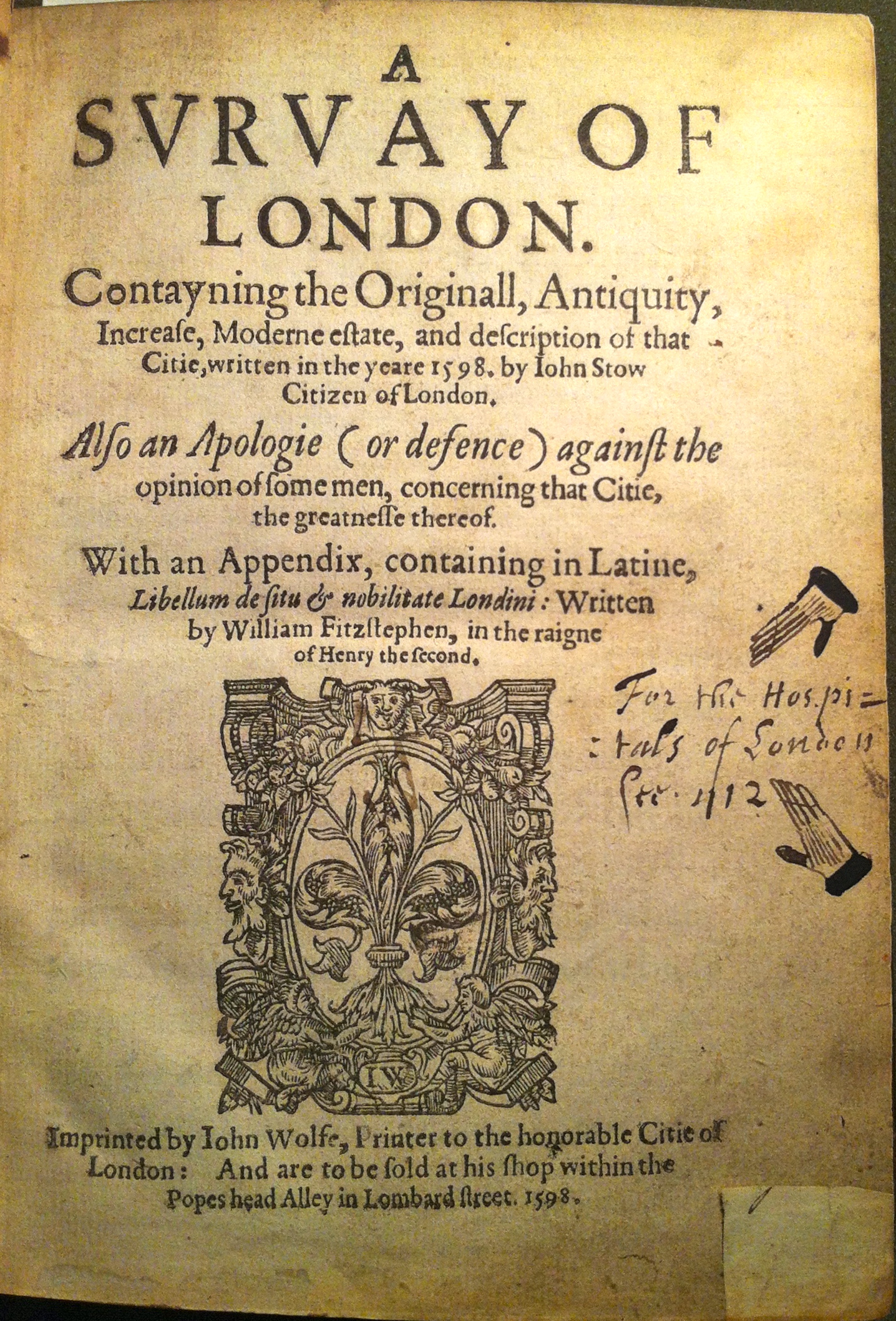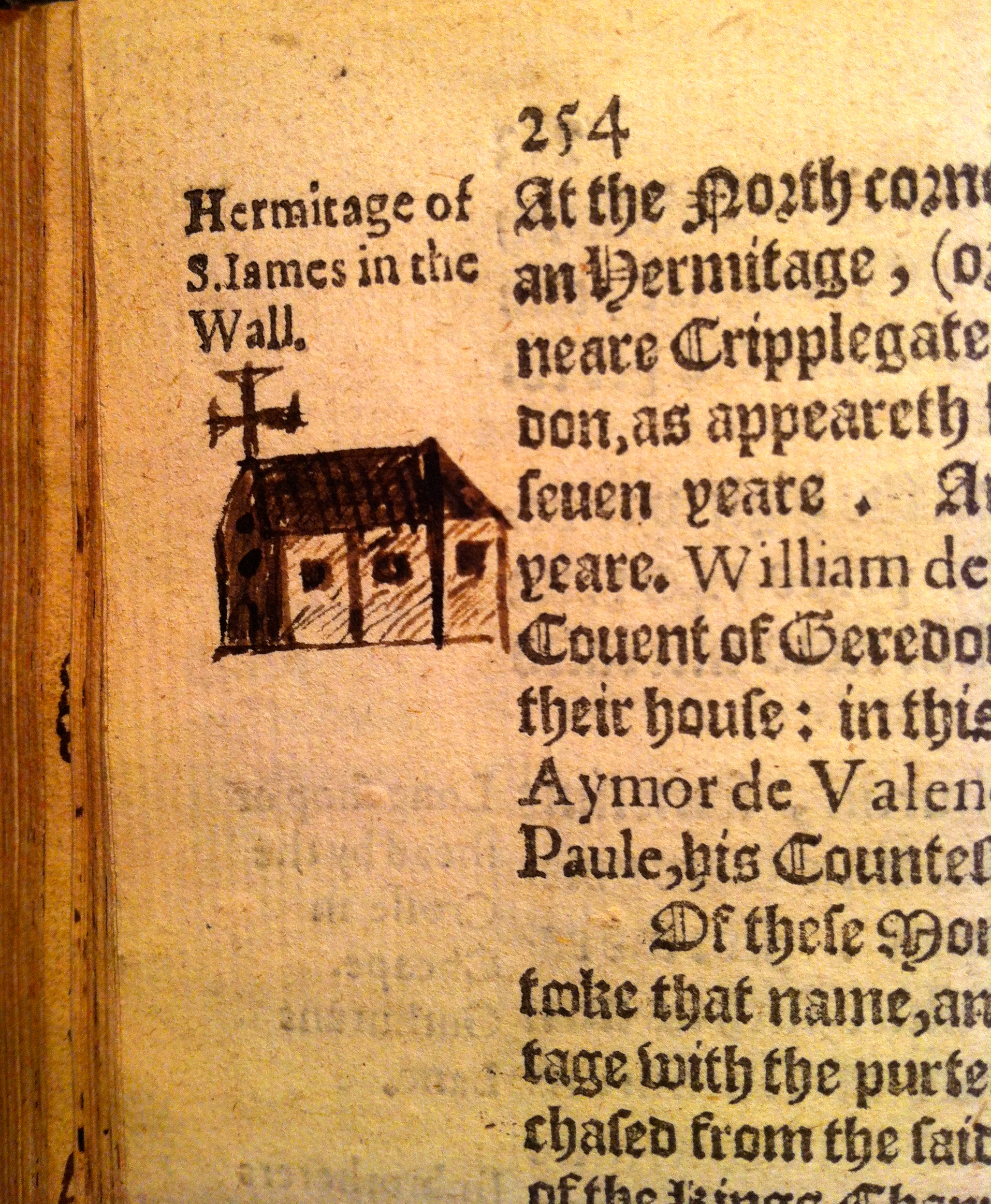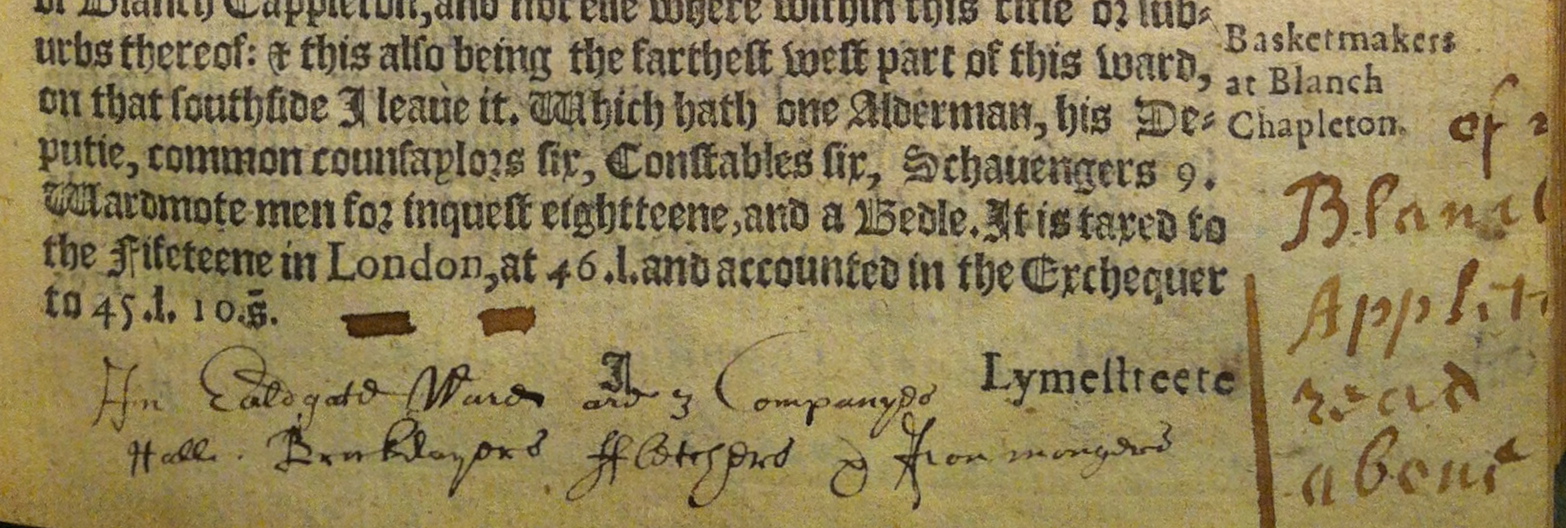Marking Up Stow’s Survey of London
When I first began working with John Stow’s Survey of London sometime in the
summer of 2012, I had no clue what I was getting into. I’m not sure I had even
heard of Stow before being assigned the task of performing TEI markup on his
text. Only a few short weeks later, though, I was so immersed in Stow’s London
that I actually began to dream about it.
What I discovered while working with Stow’s text was that marking it up was not
always obvious. The Survey introduced many new considerations regarding MoEML’s
encoding practices that our Library’s shorter texts had not. So I was grateful
when Nathan Phillips joined our team in the fall of 2012 and became as absorbed
in Stow’s text as I was. We discussed every encoding decision, deliberating
about how to present the information to future readers.
The following summer, in July 2013, I had the opportunity to visit the Folger Shakespeare Library and
examine a 1598 copy of Stow’s Survey in person. The copy I pulled up was STC
23341 copy 2, which Janelle had previously examined briefly. She had noticed
substantial manuscript marginal notes in that copy, including drawings of
various churches and other buildings named in the text, and wanted to know
more.

After a year of working with a digital copy of Stow’s text, finally holding the
physical object in my hands was an interesting experience. The quarto volume was smaller
than I
had imagined. I held it for several moments, absorbing every new detail about
this text: the smell, the texture and thickness of the pages, the four hundred
years of history that this book had survived. Turning the pages was
simultaneously familiar and disorienting. I had stared at a screen containing
that blackletter text for a year by then; I knew it well. I knew where to find
lists, long pages of Latin, Greek text, misnumbered pages. Yet this experience
was incredibly different from clicking through pages on EEBO, or scrutinizing
thumbnails in search of a particular page.
The most remarkable thing about this particular copy is the marginal notes. Roughly
seventy-five percent of the 500 pages are marked up. My
task at the Folger was to photograph every note in the book. Although we’d
initially budgeted a day for this, the sheer volume of notes meant that it took
me almost three whole days to work through the text. My daily emails back to
MoEML were filled with astonishment over the amount and the detail of the
marginal inscriptions.
![John Gibbon [Johan Gybbon, Hand B] inserts a leaf and adds to Stow’s text. Photo by Sarah Milligan courtesy of the Folger Shakespeare Library.](graphics/IMG_6528.jpg)
Johan Gybbon,Hand B] inserts a leaf and adds to Stow’s text. Photo by Sarah Milligan courtesy of the Folger Shakespeare Library.
I identified two separate hands responsible for these marginal notes. The first hand
(Hand A) made
only minor comments through the text; the second (Hand B), who names himself as John
Gibbon, interacts extensively with the text. Gibbon draws manicules (pointing
hands) to significant passages, the most common type of manuscript marginalia in early
modern books. Unusually, however, he develops a system of symbols and drawings that
he uses throughout. Mentions in the original text of coats of arms are marked by a
simple drawing of a coat of arms. Stow’s lists of the dead
buried in churches are highlighted by a drawing of a tomb. Likewise, drawings of
bells accompany any mention of them. Most impressively, many of the buildings
named by Stow are decorated by marginal drawings of these buildings. Although
some of the buildings are generic (a tower or an almshouse always has a similar
drawing), others suggest greater thought behind the drawing.

We are still trying to determine the significance of these
distinctive drawings of buildings. They may not necessarily be eyewitness
drawings, but determining exactly what they mean will require more research.
Chances are that Gibbon was reading through Stow after the Great Fire of London,
so perhaps his comments and drawings are meant to update the Survey. Besides adding the drawings, Gibbon also corrects Stow on certain details (even
his grammatical
errors), or provides updated information. He inserts leaves into the text to fill
in anything he believes is missing. He even responds to or corrects information
written by Hand A.

As I turned through the pages and photographed those notes and drawings, I began
to form an image of the person who meticulously marked up this text. I emailed
Nathan to let him know what I was finding and how astounded I was by the detail
of these marginal notes. Nathan pointed out that we had been reading through
Stow with the same level of meticulousness.
My trip to the Folger began to answer some of the research questions we had been
forming, and, like any good research trip, produced many more new questions to
consider. As we go through the hundreds of photographs I brought home, we
are looking forward to tackling these questions, finding out more about our two
marginators. A quick search of the ODNB for
Johan Gybbonor variants on that name led me to John Gibbon, a London-born herald who lived from 1629-1718. I corroborated his identity by cross-referencing details of his biography with the details provided in the marginal notes. According to the ODNB, Gibbon was baptised and buried in St. Mary Aldermary. Hand Two notes that this church is where his parents are buried, and close to where he himself was born. I have no doubt that more careful examination of the marginal notes in this Stow text will reveal further information about its marginators.

Heere my father and mother lye Buried / Jo: Gibbon / and I was borne there.Photo by Sarah Milligan courtesy of the Folger Shakespeare Library.
However, what strikes me most about my experience working with this physical
edition of the text is what Nathan said to me. John Gibbon and I read Stow’s text in very similar ways. We comb through
it marking it up, identifying errors,
cross-referencing, and asking questions. So while I spent a year staring at two
computer screens—one with a scan, and the other with XML text—and John Gibbon
worked with a particular copy of the 1598 edition of the Survey of London, and while we may have different goals and audiences, our interaction with Stow’s
text has
been remarkably similar. Perhaps John Gibbon even had dreams about Stow too.
References
-
Citation
Early English Books Online (EEBO). Proquest LLC. Subscription.This item is cited in the following documents:
-
Citation
ODNB. The Oxford Dictionary of National Biography. Online edition. Ed. Lawrence Goldman. Web. [The ODNB is a subscription database. Most university and college institutions in North America and Europe will have a subscription.] -
Citation
Stow, John. A SVRVAY OF LONDON. Contayning the Originall, Antiquity, Increase, Moderne estate, and description of that Citie, written in the yeare 1598. by Iohn Stow Citizen of London. Also an Apologie (or defence) against the opinion of some men, concerning that Citie, the greatnesse thereof. With an Appendix, containing in Latine, Libellum de situ &nobilitate Londini: written by William Fitzstephen, in the raigne of Henry the second. London: John Windet for John Wolfe, 1598. STC 23341. Huntington Library copy. Reprint. EEBO. Web.This item is cited in the following documents:
Cite this page
MLA citation
.
Marking Up Stow’s Survey of London.The Map of Early Modern London, edited by , U of Victoria, 20 Jun. 2018, mapoflondon.uvic.ca/BLOG9.htm.
Chicago citation
.
Marking Up Stow’s Survey of London.The Map of Early Modern London. Ed. . Victoria: University of Victoria. Accessed June 20, 2018. http://mapoflondon.uvic.ca/BLOG9.htm.
APA citation
2018. Marking Up Stow’s Survey of London. In (Ed), The Map of Early Modern London. Victoria: University of Victoria. Retrieved from http://mapoflondon.uvic.ca/BLOG9.htm.
RIS file (for RefMan, EndNote etc.)
Provider: University of Victoria Database: The Map of Early Modern London Content: text/plain; charset="utf-8" TY - ELEC A1 - Milligan, Sarah ED - Jenstad, Janelle T1 - Marking Up Stow’s Survey of London T2 - The Map of Early Modern London PY - 2018 DA - 2018/06/20 CY - Victoria PB - University of Victoria LA - English UR - http://mapoflondon.uvic.ca/BLOG9.htm UR - http://mapoflondon.uvic.ca/xml/standalone/BLOG9.xml ER -
RefWorks
RT Web Page SR Electronic(1) A1 Milligan, Sarah A6 Jenstad, Janelle T1 Marking Up Stow’s Survey of London T2 The Map of Early Modern London WP 2018 FD 2018/06/20 RD 2018/06/20 PP Victoria PB University of Victoria LA English OL English LK http://mapoflondon.uvic.ca/BLOG9.htm
TEI citation
<bibl type="mla"><author><name ref="#MILL2"><surname>Milligan</surname>, <forename>Sarah</forename></name></author>. <title level="a">Marking Up Stow’s <title level="m">Survey of London</title></title>. <title level="m">The Map of Early Modern London</title>, edited by <editor><name ref="#JENS1"><forename>Janelle</forename> <surname>Jenstad</surname></name></editor>, <publisher>U of Victoria</publisher>, <date when="2018-06-20">20 Jun. 2018</date>, <ref target="http://mapoflondon.uvic.ca/BLOG9.htm">mapoflondon.uvic.ca/BLOG9.htm</ref>.</bibl>Personography
-
Janelle Jenstad
JJ
Janelle Jenstad, associate professor in the department of English at the University of Victoria, is the general editor and coordinator of The Map of Early Modern London. She is also the assistant coordinating editor of Internet Shakespeare Editions. She has taught at Queen’s University, the Summer Academy at the Stratford Festival, the University of Windsor, and the University of Victoria. Her articles have appeared in the Journal of Medieval and Early Modern Studies, Early Modern Literary Studies, Elizabethan Theatre, Shakespeare Bulletin: A Journal of Performance Criticism, and The Silver Society Journal. Her book chapters have appeared (or will appear) in Performing Maternity in Early Modern England (Ashgate, 2007), Approaches to Teaching Othello (Modern Language Association, 2005), Shakespeare, Language and the Stage, The Fifth Wall: Approaches to Shakespeare from Criticism, Performance and Theatre Studies (Arden/Thomson Learning, 2005), Institutional Culture in Early Modern Society (Brill, 2004), New Directions in the Geohumanities: Art, Text, and History at the Edge of Place (Routledge, 2011), and Teaching Early Modern English Literature from the Archives (MLA, forthcoming). She is currently working on an edition of The Merchant of Venice for ISE and Broadview P. She lectures regularly on London studies, digital humanities, and on Shakespeare in performance.Roles played in the project
-
Author
-
Author of Abstract
-
Author of Stub
-
Author of Term Descriptions
-
Author of Textual Introduction
-
Compiler
-
Conceptor
-
Copy Editor
-
Course Instructor
-
Course Supervisor
-
Course supervisor
-
Data Manager
-
Editor
-
Encoder
-
Encoder (Structure and Toponyms)
-
Final Markup Editor
-
GIS Specialist
-
Geographic Information Specialist
-
Geographic Information Specialist (Modern)
-
Geographical Information Specialist
-
JCURA Co-Supervisor
-
Main Transcriber
-
Markup Editor
-
Metadata Co-Architect
-
MoEML Transcriber
-
Name Encoder
-
Peer Reviewer
-
Primary Author
-
Project Director
-
Proofreader
-
Researcher
-
Reviser
-
Second Author
-
Second Encoder
-
Toponymist
-
Transcriber
-
Transcription Proofreader
-
Vetter
Contributions by this author
Janelle Jenstad is a member of the following organizations and/or groups:
Janelle Jenstad is mentioned in the following documents:
-
-
Tye Landels-Gruenewald
TLG
Research assistant, 2013-15, and data manager, 2015 to present. Tye completed his undergraduate honours degree in English at the University of Victoria in 2015.Roles played in the project
-
Author
-
Author of Term Descriptions
-
CSS Editor
-
Compiler
-
Conceptor
-
Copy Editor
-
Data Manager
-
Editor
-
Encoder
-
Geographic Information Specialist
-
Markup Editor
-
Metadata Architect
-
MoEML Researcher
-
Name Encoder
-
Proofreader
-
Researcher
-
Toponymist
-
Transcriber
Contributions by this author
Tye Landels-Gruenewald is a member of the following organizations and/or groups:
Tye Landels-Gruenewald is mentioned in the following documents:
-
-
Kim McLean-Fiander
KMF
Director of Pedagogy and Outreach, 2015–present; Associate Project Director, 2015–present; Assistant Project Director, 2013-2014; MoEML Research Fellow, 2013. Kim McLean-Fiander comes to The Map of Early Modern London from the Cultures of Knowledge digital humanities project at the University of Oxford, where she was the editor of Early Modern Letters Online, an open-access union catalogue and editorial interface for correspondence from the sixteenth to eighteenth centuries. She is currently Co-Director of a sister project to EMLO called Women’s Early Modern Letters Online (WEMLO). In the past, she held an internship with the curator of manuscripts at the Folger Shakespeare Library, completed a doctorate at Oxford on paratext and early modern women writers, and worked a number of years for the Bodleian Libraries and as a freelance editor. She has a passion for rare books and manuscripts as social and material artifacts, and is interested in the development of digital resources that will improve access to these materials while ensuring their ongoing preservation and conservation. An avid traveler, Kim has always loved both London and maps, and so is particularly delighted to be able to bring her early modern scholarly expertise to bear on the MoEML project.Roles played in the project
-
Associate Project Director
-
Author
-
Author of MoEML Introduction
-
CSS Editor
-
Compiler
-
Contributor
-
Copy Editor
-
Data Contributor
-
Data Manager
-
Director of Pedagogy and Outreach
-
Editor
-
Encoder
-
Encoder (People)
-
Geographic Information Specialist
-
JCURA Co-Supervisor
-
Managing Editor
-
Markup Editor
-
Metadata Architect
-
Metadata Co-Architect
-
MoEML Research Fellow
-
MoEML Transcriber
-
Proofreader
-
Researcher
-
Second Author
-
Secondary Author
-
Secondary Editor
-
Toponymist
-
Vetter
Contributions by this author
Kim McLean-Fiander is a member of the following organizations and/or groups:
Kim McLean-Fiander is mentioned in the following documents:
-
-
Nathan Phillips
NAP
Graduate Research Assistant, 2012-14. Nathan Phillips completed his MA at the University of Victoria specializing in medieval and early modern studies in April 2014. His research focuses on seventeenth-century non-dramatic literature, intellectual history, and the intersection of religion and politics. Additionally, Nathan is interested in textual studies, early-Tudor drama, and the editorial questions one can ask of all sixteenth- and seventeenth-century texts in the twisted mire of 400 years of editorial practice. Nathan is currently a Ph.D. student in the Department of English at Brown University.Roles played in the project
-
Author
-
Date Encoder
-
Editor
-
Encoder
-
Formeworke Encoder
-
Gap Encoder
-
Markup Editor
-
MoEML Transcriber
-
Name Encoder
-
Researcher
-
Toponymist
Contributions by this author
Nathan Phillips is mentioned in the following documents:
-
-
Joey Takeda
JT
Programmer, 2018-present; Junior Programmer, 2015 to 2017; Research Assistant, 2014 to 2017. Joey Takeda is an MA student at the University of British Columbia in the Department of English (Science and Technology research stream). He completed his BA honours in English (with a minor in Women’s Studies) at the University of Victoria in 2016. His primary research interests include diasporic and indigenous Canadian and American literature, critical theory, cultural studies, and the digital humanities.Roles played in the project
-
Author
-
Author of Abstract
-
Author of Stub
-
CSS Editor
-
Compiler
-
Conceptor
-
Copy Editor
-
Data Manager
-
Date Encoder
-
Editor
-
Encoder
-
Encoder (Bibliography)
-
Geographic Information Specialist
-
Geographic Information Specialist (Agas)
-
Junior Programmer
-
Markup Editor
-
Metadata Co-Architect
-
MoEML Encoder
-
MoEML Transcriber
-
Programmer
-
Proofreader
-
Researcher
-
Second Author
-
Toponymist
-
Transcriber
-
Transcription Editor
Contributions by this author
Joey Takeda is a member of the following organizations and/or groups:
Joey Takeda is mentioned in the following documents:
-
-
Zaqir Virani
ZV
Graduate Research Assistant, 2013-14. Zaqir Virani completed his MA at the University of Victoria in April 2014. He received his BA from Simon Fraser University in 2012, and has worked as a musician, producer, and author of short fiction. His research focuses on the linkage of sound and textual analysis software and the work of Samuel Beckett.Roles played in the project
-
Author
-
CSS Editor
-
Conservator
-
Copy Editor
-
Encoder
-
First Transcriber
-
Markup Editor
-
MoEML Transcriber
-
Researcher
-
Second Transcriber
-
Toponymist
Contributions by this author
Zaqir Virani is a member of the following organizations and/or groups:
Zaqir Virani is mentioned in the following documents:
-
-
Martin D. Holmes
MDH
Programmer at the University of Victoria Humanities Computing and Media Centre (HCMC). Martin ported the MOL project from its original PHP incarnation to a pure eXist database implementation in the fall of 2011. Since then, he has been lead programmer on the project and has also been responsible for maintaining the project schemas. He was a co-applicant on MoEML’s 2012 SSHRC Insight Grant.Roles played in the project
-
Author
-
Author of abstract
-
Conceptor
-
Encoder
-
Name Encoder
-
Post-conversion and Markup Editor
-
Programmer
-
Proofreader
-
Researcher
Contributions by this author
Martin D. Holmes is a member of the following organizations and/or groups:
Martin D. Holmes is mentioned in the following documents:
-
-
Sarah Milligan
SM
MoEML Research Affiliate. Research assistant, 2012-14. Sarah Milligan completed her MA at the University of Victoria in 2012 on the invalid persona in Elizabeth Barrett Browning’s Sonnets from the Portuguese. She has also worked with the Internet Shakespeare Editions and with Dr. Alison Chapman on the Victorian Poetry Network, compiling an index of Victorian periodical poetry.Roles played in the project
-
Author
-
Compiler
-
Copy Editor
-
Date Encoder
-
Editor
-
Encoder
-
Final Markup Editor
-
Formeworke Encoder
-
Gap Encoder
-
Markup Editor
-
MoEML Transcriber
-
Researcher
-
Second Author
-
Toponymist
Contributions by this author
Sarah Milligan is a member of the following organizations and/or groups:
Sarah Milligan is mentioned in the following documents:
-
Locations
-
St. Mary Aldermary is mentioned in the following documents:
-
Cordwainer Street Ward
MoEML is aware that the ward boundaries are inaccurate for a number of wards. We are working on redrawing the boundaries. This page offers a diplomatic transcription of the opening section of John Stow’s description of this ward from his Survey of London.Cordwainer Street Ward is mentioned in the following documents:

